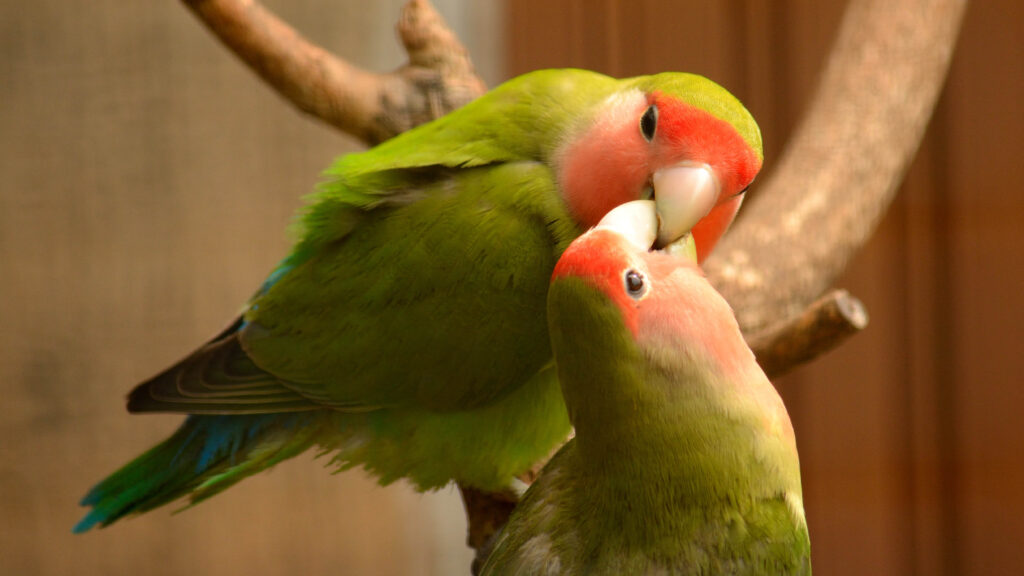Lovebirds typically require around 10 to 12 hours of sleep per night. A consistent sleep schedule helps maintain their health and well-being.
Ensuring your lovebirds get the right amount of rest is crucial for their overall health. These vibrant and sociable birds thrive on routine, much like humans do. A good night’s sleep allows them to maintain their energy levels, keep up with their inquisitive nature, and support a strong immune system.
Since they’re naturally accustomed to the light cycles of their native habitats, mimicking these conditions in your home can contribute to their sleep quality. Covering their cage with a light cloth can signal bedtime, and turning off any harsh lights will set a restful environment. Remember, a well-rested lovebird is a happy and active companion, so prioritizing their sleep is key to nurturing their vivacious personalities.

Credit: pethelpful.com
The Sleep Cycle Of Lovebirds
Lovebirds, with their vibrant colors and social nature, charm bird enthusiasts around the globe. Not just their daytime antics, but understanding their sleep cycle is also essential for their well-being. Proper rest is vital for these feathered friends. Knowing how much sleep they need keeps lovebirds healthy and happy.
Comparing Bird And Human Sleep Patterns
Do lovebirds sleep like us? Surprisingly, lovebird and human sleep patterns differ. Unlike the 7-9 hours recommended for humans, lovebirds need around 10-12 hours of sleep at night. Their sleep schedule aligns with sunset and sunrise.
- Light: Lovebirds rely on natural light patterns.
- Rhythm: They maintain a consistent sleep-wake cycle.
- Quiet: Lovebirds prefer tranquil environments for undisturbed rest.
Stages Of Sleep In Lovebirds
Exploring stages of sleep reveals how lovebirds recharge. Their sleep includes both light and deep phases, crucial for proper rest.
| Stage | Description |
|---|---|
| Light Sleep | Eyes part-closed, quick to wake |
| Deep Sleep | Eyes closed, reduced responsiveness |
Restful deep sleep: A sign of a relaxed lovebird. Secure environment cues such as soft nesting areas encourage this stage.

Credit: www.alamy.com
Factors Influencing Lovebird Sleep
Sleep is crucial for your feathered friend’s health. Many elements affect how well lovebirds sleep. Let’s dive into some of these key factors.
The Role Of Light Exposure
Lovebirds need a dark, calm space to sleep properly. Natural light tells them when to wake and sleep. Twelve hours of light and twelve hours of darkness is ideal. This cycle keeps their internal clock regular. During the day, natural sunlight is beneficial. At night, keeping their environment dark ensures a good night’s rest. Some owners use a specific bird night light or cover the cage with a light-blocking cloth.
Importance Of A Quiet Environment
Silence is golden for your lovebird’s sleep. Loud noises can disrupt their rest. Lovebirds prefer a gentle environment free from sudden sounds. This includes turning off the television or radio. Ensure their sleeping area is away from household activity especially at night. A consistent, tranquil atmosphere promotes uninterrupted sleep. This helps maintain their overall health and happiness.
Optimal Sleep Duration For Lovebirds
To keep lovebirds happy and healthy, sleep is crucial. These social and vibrant birds require enough rest for overall wellbeing. Understanding how much sleep they need ensures they stay energetic and maintain good health.
Age And Sleep Needs
Lovebirds of different ages have varying sleep requirements. Just like humans, younger lovebirds need more sleep than adults. Here’s a quick breakdown:
| Age Group | Hours of Sleep Needed |
|---|---|
| Baby Lovebirds (0-6 months) | 12-14 hours |
| Juvenile Lovebirds (6-18 months) | 10-12 hours |
| Adult Lovebirds (18 months+) | 10-12 hours |
It’s vital to create a sleep-friendly environment to support their needs. This includes a dark, quiet space at night.
Signs Of Sleep Deprivation
Sleep-deprived lovebirds may show several signs, which bird owners should not ignore. These include:
- Constant squawking or irritability
- Frequent napping or falling asleep during the day
- Less interest in interaction or play
- Feather plucking or other self-harming behaviors
Recognizing these signs early helps prevent health issues related to lack of sleep.
Housing Setup And Its Effect On Sleep
Proper housing setup is crucial for your lovebird’s optimal sleep. A lovebird needs between 10 and 12 hours of sleep each night. Their cage environment has a significant impact on their ability to rest well. Comfort and security in their housing encourage good sleep patterns.
Cage Size And Location
Finding the right cage size and location for your lovebird can make a huge difference in their sleep quality. A spacious cage allows for free movement and reduces stress. A typical cage size for a pair of lovebirds should be at least 24 x 24 x 24 inches. Place the cage in a quiet, low-traffic area to prevent disturbances. Avoid direct sunlight and drafts to help your lovebird feel safe and maintain a consistent sleep schedule.
Perches And Comfort
Inside the cage, perches play a vital role in your lovebird’s sleep. The perches should be of varying diameters to promote foot health. Softwood perches can provide comfort. Ensure there are enough perches so your lovebird can choose the most comfortable position. Soft nesting materials allow for a cozy sleep spot. A comfortable sleeping environment helps your lovebird relax and get restorative sleep.
Common Sleep Disruptions In Captivity
Like us, lovebirds need quality sleep to stay healthy.
In captivity, their sleep often gets disrupted.
Why does this happen? Let’s find out.
Identifying Stressors
Many things can stress your lovebird at night:
- Too much light: Birds need dark to sleep well.
- Loud sounds: Even low noise can scare them.
- Small cages: They need space to feel safe.
Check these things to make sure your bird can rest.
Handling Nocturnal Disturbances
Noise and light can disturb lovebirds at night.
| Problem | Solution |
|---|---|
| Loud TV or music | Turn them off or lower the volume. |
| Bright street lights | Use blackout curtains or move the cage. |
| Other pets | Keep pets in different rooms at night. |
Set a routine for your lovebird:
- Same bedtime each night.
- Quiet and dim environment.
- Comfortable temperature.
This will help your bird sleep without trouble.
Enhancing Sleep Quality For Lovebirds
Enhancing Sleep Quality for Lovebirds is crucial for their overall well-being. Just like humans, these colorful avians need restful sleep to stay healthy and happy. But how can pet owners ensure their feathered friends are getting the snooze they need? Let’s explore some effective strategies to promote better sleep for lovebirds.
Consistent Sleep Schedules
Lovebirds thrive on routine. Establishing a regular sleep cycle is the first step toward quality rest. Here’s what to do:
- Set a fixed bedtime and wake-up time for your birds.
- Stick to these times every day, even on weekends.
- Dim the lights in the evening to signal bedtime.
Creating A Sleep-inducing Environment
An ideal sleep environment is quiet and dark. Here’s how to create one:
- Use a cover for the cage that blocks out light.
- Keep the room noise-free during sleep hours.
- Ensure the temperature is comfortable for your lovebirds.
- Provide a comfy perch away from drafts.
A comfortable nest area is key to a restful night for lovebirds. Incorporate these practices, and your birds are likely to wake up refreshed and ready for a new day.
Monitoring Lovebird Sleep Patterns
Understanding your lovebird’s sleep needs is crucial for their health and happiness. Monitoring Lovebird Sleep Patterns helps ensure they get enough rest. Lovebirds generally need around 10 to 12 hours of sleep each night. Let’s explore how to recognize if your lovebird is sleeping well and when to seek advice from a vet.
Recognizing Healthy Sleep Behavior
Healthy sleep is vital for your lovebird’s well-being. Signs of good sleep patterns include:
- Quiet and still during sleep hours
- Sleeping on one foot with the head tucked
- Easily waking up in the morning
- Active and alert during the day
Watch for consistent bedtime routines and a calm environment at night. This ensures quality sleep. Maintain a dark and quiet space for them to rest without disturbances.
When To Consult With A Veterinarian
If you notice changes in your lovebird’s sleep patterns, take action. Look for:
| Behavior | Action |
|---|---|
| Excessive sleepiness during the day | Seek vet advice |
| Difficulty falling asleep | Consult a vet |
| Restlessness at night | Check with a veterinarian |
Abnormal behavior may indicate health issues. Contact your vet for a detailed checkup if you see signs of sleep trouble.
Remember, each lovebird is unique. Some variations in sleep are normal. But significant changes may require expert advice. Keep an eye on your feathered friend to ensure they’re getting the rest they need.
:strip_icc()/facts-about-lovebirds-390823_v2-5b980b5146e0fb0050a477a7.png)
Credit: www.thesprucepets.com
Balancing Sleep And Activity
For lovebirds, a harmonious life intertwines rest with play. These feathered friends adore a good night’s sleep, as much as lively activities during the day. Discover the right blend between dreamland visits and daytime frolics to keep your pet vibrant and healthy.
Daily Exercise Needs
Just like us, lovebirds need daily exercise. It maintains their fitness and stirs their intellect. A happy lovebird enjoys various activities, from flying to climbing or playing with toys. Consider these essentials for your lovebird:
- Free flight time inside a safe room.
- Interactive toys to solve and explore.
- At least 30 minutes of dedicated playtime.
Engaging your bird in these ways promotes a healthy body and sharp mind. Regular physical activity leads to better sleep at night.
Interactive Play And Rest Balance
Finding the perfect equilibrium between nap times and play sessions is vital. This balance prevents boredom and overexertion. Lovebirds typically require:
| Daytime | Evening |
|---|---|
| 10-12 hours of daylight activity | 12-14 hours of quiet sleep time |
Dedicate time each day for interaction. Play with your lovebird to keep its mind active. Then, ensure it has a cozy, dark, and quiet spot to snooze. Respect the natural sleep cycle of your pet for better health and happiness.
Conclusion
Understanding your lovebird’s sleep needs ensures a happy, healthy pet. Aim for 10-12 hours of darkness at night. Create a tranquil sleep environment for their wellbeing. Remember, consistent sleep patterns are key. Prioritize your feathered friend’s rest for their vibrant life.
Sweet dreams to your loveable lovebird!
Ryan Everhart is a passionate bird enthusiast and blogger, primarily writing on his website, Avian Whispers. His journey into the world of bird blogging began with a deep interest in parrots, a species that captivated his attention for their intelligence and social behavior. Over time, his content expanded to cover a broader range of bird species, offering insights into bird behavior, care, habitats, and conservation.
Ryan is dedicated to educating his audience, which includes both new bird owners and seasoned enthusiasts. His writing is filled with personal experiences, expert knowledge, and practical advice on bird care. Through Avian Whispers, he aims to foster a deeper appreciation for birds, emphasizing their role in nature and the joys of having them as pets.
Starting with articles focused on parrots, Ryan’s work now encompasses a diverse range of topics such as feeding, training, habitat enrichment, and bird health. His love for birds extends beyond parrots, diving into various avian species. His informative and heartfelt writing reflects his commitment to the well-being of birds and the desire to help others connect with these creatures.
As a growing voice in the bird blogging community, Ryan strives to provide a platform where bird lovers can learn, share experiences, and connect over a shared passion for avian life. His blogs are not only educational but also serve as a reminder of the importance of protecting and nurturing the bond between humans and birds.




